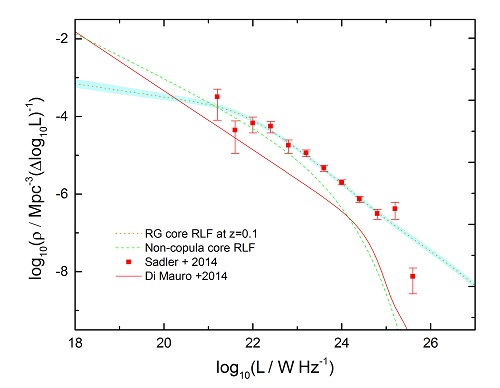Recently, Dr. YUAN Zunli and his colleagues from Yunnan Observatories (YNAO) of Chinese Academy of Sciences, as well as his collaborators from University of Bristol (UK) and Nanjing University, determined the core radio luminosity function of radio AGNs via a novel statistical approach known as "Copula". This study was published in The Astrophysical Journal Supplement Series.
The radio luminosity functions (RLFs) of active galactic nuclei (AGNs) are traditionally measured based on total emission, which does not reflect the current activity of the central black hole. The increasing interest in compact radio cores of AGNs motivates determination of the RLF based on core emission. The core RLF helps us to understand the nature of the instantaneous radio activity in massive galaxies, as well as the accretion process onto the supermassive black holes. However, the traditional methods have difficulty in determine the core RLF due to the sample completeness problem.
YUAN's group proposed an alternative approach. Based on comprehensive observed data, they explore the relationship between core luminosity (Lc) and total luminosity (Lt) via a powerful statistical tool called “Copula.” The core RLF was then derived as a convolution of the Lc-Lt relation with the total RLF that was determined by their previous work. The results are in good agreement with the latest observation data by SADLER's group from Australia (Fig. 1).
Researchers found that the core RLF presents a very weak luminosity-dependent evolution, with the number density peaking around z~0.8 for all luminosities (Fig. 2). The redshift at which core RLF peaks is lower than that of the peak of BH growth.
"The reason for this is not entirely clear,” YUAN says, “but it is presumably related to redshift dependent accretion efficiency and jet triggering.”
This research is co-sponsored by the National Natural Science Foundation of China, Key Laboratory for the Structure and Evolution of Celestial Objects of Chinese Academy of Sciences, Center for Astronomical Mega-Science of Chinese Academy of Sciences, and Yunnan Province of China.

Fig. 1. Comparison of the core RLF (orange dotted line) with SADLER’s observation (red solid
squares). Image by YUAN Zunli

Fig. 2. Core RLF as a function of redshift. From top to bottom, the curves represent that incremental core luminosities are taken. Image by YUAN Zunli
Contact
YUAN Zunli
High energy astrophysics research group, YNAO
Email: yuanzunli@ynao.ac.cn